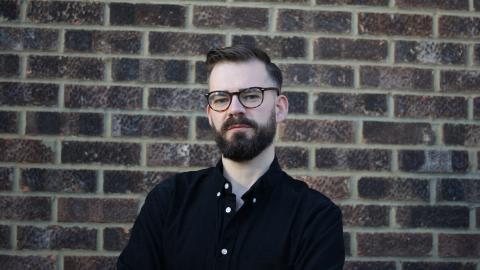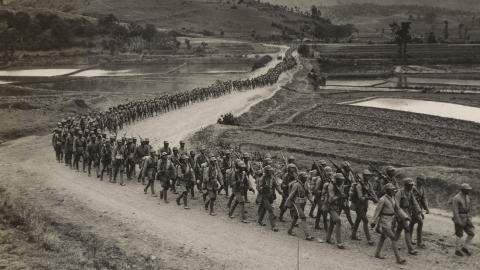The Sobibor death camp uprising of 1943
In what was the most daring mass-escape from a concentration camp during WWII, hundreds of Jewish prisoners fought back against their captors.
Great Escapes With Morgan Freeman tells the stories of the most daring prison breaks in history and the manhunts that immediately followed. The show starts Tuesday, 1st October at 10pm on Sky History.
In the woods on the outskirts of the small village of Sobibor in eastern Poland lies a pathway leading to a large open clearing containing an unusual white pyramid. This is the ‘Road to Heaven’ leading to the site of what once were vast, open-air cremation pits. They are all that remains of the Nazi extermination camp that once existed here in the 1940s.
The Road to Heaven was the path down which Jews from Poland, the Soviet Union, the Netherlands, France, Germany, Austria, Slovakia and Bohemia and Moravia were led to their deaths in Sobibor’s gas chambers. Among their number were the socialist writer Else Feldmann, the celebrated magician Michel Velleman and three members of the 1928 gold medal-winning Dutch Olympics gymnastics team. Between May 1942 and October 1943, an estimated 250,000 men, women and children were killed in Sobibor.
Built to carry out murder on an industrial scale, by the spring of 1943, the camp’s gas chambers were starting to be used less frequently as the numbers of Jews being sent to their deaths began to dwindle. Rumours started to circulate around the camp that it would soon be closed down and dismantled, and that meant one thing – death for the Sonderkommandos and the other slave labourers who worked there.
Sonderkommandos were Jews who were forced to dispose of the bodies of the death camps’ victims after they had been gassed. They were treated differently to other prisoners; given better rations, better accommodation and access to things like cigarettes and medicines brought into the camps by the Nazis’ unsuspecting victims.
It was a grisly life, and one most Sonderkommandos had no idea existed until they were drafted into the work units on arrival at the camps. Oftentimes, their first shift involved carting away the bodies of their own family members. It was not a long life either. Sonderkommandos knew the Nazis’ dirty secrets, and most were killed after three months unless they possessed certain skills that proved useful to their masters.
The Sonderkommandos of Sobibor realized the closure of the camp meant certain death for everyone working there, even those who the Nazis considered especially useful. They decided to form an underground committee with the aim of coming up with a way they could escape before they were all put to death. The committee was led by rabbi’s son Leon Feldhendler, who hailed from the nearby town of Zolkiewka.
Many options were considered including building an escape tunnel under the fence and the minefield that surrounded the camp, but it wasn’t until September that the ball really got rolling when the underground received a surprise boost to its numbers. Captured Soviet soldiers were transported to the camp, and those who survived the selection process at the railway station were drafted into the Sonderkommando.
The underground now had seasoned soldiers in its ranks, including Lieutenant Aleksandr ’Sasha’ Aronovich Pechersky. Captured during the Battle of Moscow, Pechersky was sent to a POW camp near Minsk until a routine medical inspection revealed he was circumcised. Admitting to being Jewish, Pechersky was transferred first to an SS-run Jewish slave labour camp, and then on to Sobibor.
This military boost to the camp’s numbers was just what was needed if an escape was to stand any chance of being successful. Pechersky was put in charge of the committee, with Feldhendler being named his second-in-command.
A plan was quickly devised. Rudimentary weapons would be made in the camp’s workshops and hidden away until needed. The camp’s SS officers would then be lured into two separate buildings on the ruse that new uniforms and boots had arrived for them to try on, or that they were required for measurements for new uniforms. Once lured to the buildings, the SS men would be killed. Once all the SS officers were disposed of and their weapons seized, the camp’s armory would be raided, the remaining buildings would be set on fire and the camp’s Ukrainian guards would be either killed or captured. Then all six hundred prisoners would walk out of the main gate and escape into the woods. After that, it would be every man and woman for themselves.
On the 14th of October, the plan was set in motion. At four in the afternoon, the killings began. The first SS officer to be lured to his death was Unterscharfurher Josef Wulf. Lured to a storeroom by being informed that a new coat was waiting for him, Wulf’s head was smashed in by prisoners wielding axes as he tried the coat on. His body was hidden away and the prisoners waited for their next victim. When he arrived, he was dispatched in the same way and the evidence was again concealed.
For the most part, the killings went well. The camp’s acting commandant, Untersturmfuhrer Josef Niemann, arrived at the camp’s tailor shop on his horse. He took an axe to the head while being fitted for a new uniform.
One of the killings did not go quite to plan. Scharfuhrer Kurt Beckmann was told a new leather coat had arrived for him in the same storeroom where Wulf had met his grisly end. Halfway to the storeroom, Niemann turned on his heel and went to his office instead. Three prisoners entered his office and stabbed him to death, leaving his body sitting behind his desk. Not hiding the Scharfuhrer’s body would prove a costly mistake.
In total, eleven SS officers were killed with knives and axes. As the prisoners assembled in the main courtyard of the camp for roll-call just after five o’clock, confidence was running high. However, a Ukranian guard discovered the body of Beckmann and sounded the alarm. Pechersky realised the prisoners now stood little chance of walking out of the gates. There was nothing for it – they must storm the fences.
The camp was set on fire and the armoury stormed as some of the prisoners rushed the barbed wire fences and others began tackling the guards. As the alert went around Sobibor that an escape was in progress, the remaining guards began shooting into the crowds of fleeing prisoners, some of whom had breached the fences and were fleeing across the surrounding minefield with predictably grisly results.
As the guards machine-gunned the fleeing prisoners, more and more managed to get through breaches in the fences and run towards the woods. Many were lost in the minefields, but some managed to make it to the trees thanks to the mines being cleared by the unfortunate prisoners in front of them. About three hundred men and women managed to escape the camp before order was restored; sadly, half of those prisoners died in the minefields or were killed by the guards’ machine guns.
Of the total number of people who escaped from Sobibor, it is estimated just fifty managed to survive the war.
In the days that followed, SS, Orpo and Wehrmacht units managed to hunt down and kill many more prisoners using dogs and tracker planes. For the remaining escapees who managed to evade capture, some joined up with local partisan groups, others were killed by mistrustful locals, and others went into hiding. Of the total number of people who escaped from Sobibor, it is estimated just fifty managed to survive the war.
Both Pechersky and Feldhendler evaded capture. Feldhendler went into hiding in the nearby city of Lublin. He survived the war but sadly did not survive the occupation of Poland by the Soviets. On the 2nd of April 1945, he was shot in a possible botched robbery and died of his wounds four days later. Pechersky and a small band of escapees eventually joined a local partisan unit, taking part in sabotage missions until the Nazis were driven out of Belarus by the Soviet Union. After serving in a Red Army penal unit, Pechersky received a serious foot injury that saw him ride out the end of the war in hospital. After the war, he was repeatedly refused permission to leave the Soviet Union to testify in war crimes tribunals, including an invitation to testify at the trial of Adolf Eichmann in Israel in 1961. He died on January 19th 1990.
As for the camp itself, it was torn down within days of the uprising on the orders of Heinrich Himmler. The buildings were bulldozed down to their foundations and the area where the gas chambers once stood was covered over with asphalt. The remaining prisoners who hadn’t managed to escape were either killed in the aftermath of the escape or were sent to slave labour camps elsewhere in the area. Just a handful survived to see the war come to an end.
Today, all that remains of Sobibor is the so-called ‘Road to Heaven’ leading to a large clearing that is the site of the former open-air cremation pits. A solitary white mound containing the ashes and bone fragments of prisoners stands silent witness to the quarter of a million souls who were murdered in this quiet wooded area of eastern Poland.
The Sobibor escape was the largest and most successful of its kind during World War II. Remarkably, some of those who escaped are still alive today. Their existence bears witness to the fact that even in the very darkest of times, the faintest chink of light will always break through the gloom.
















